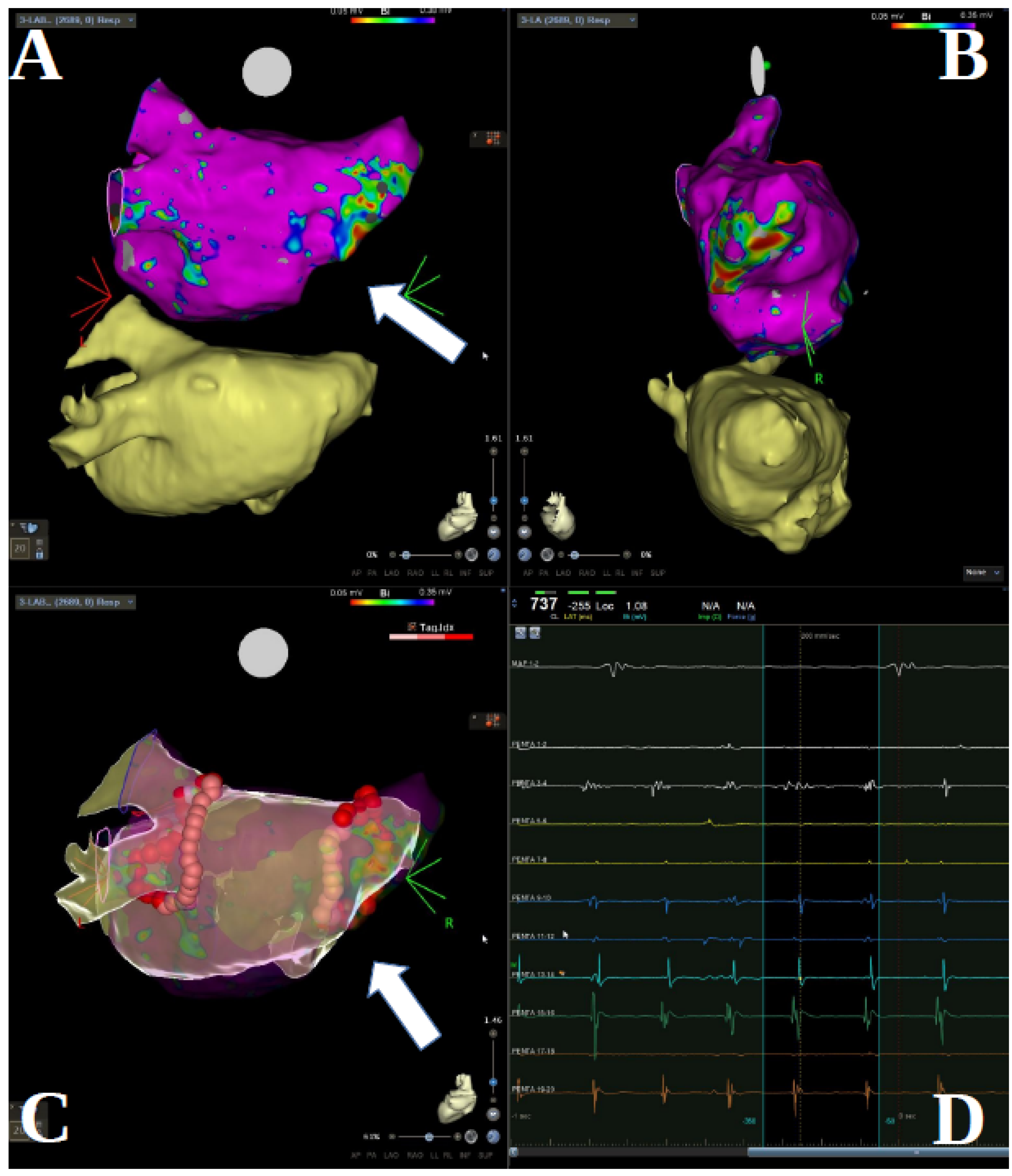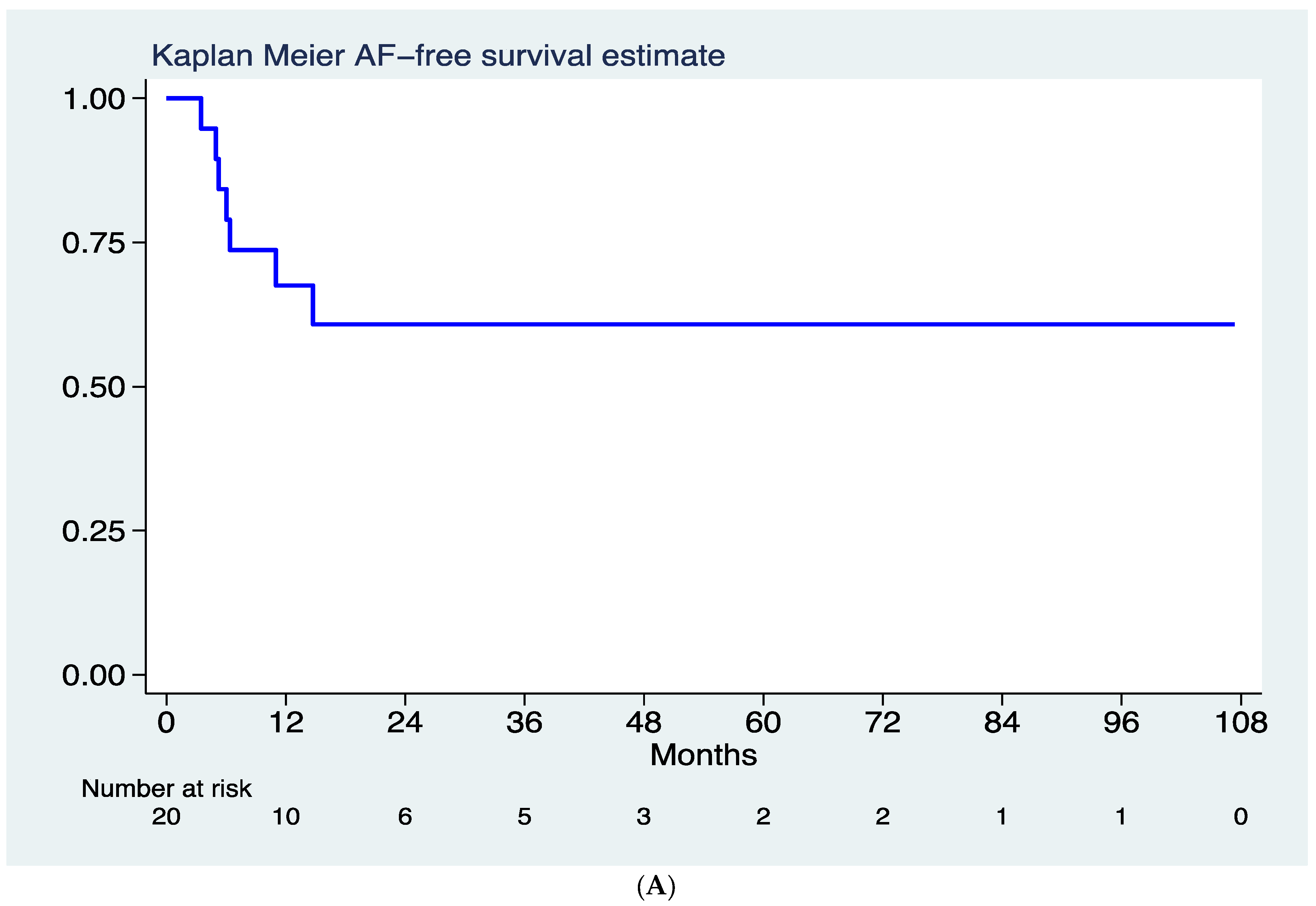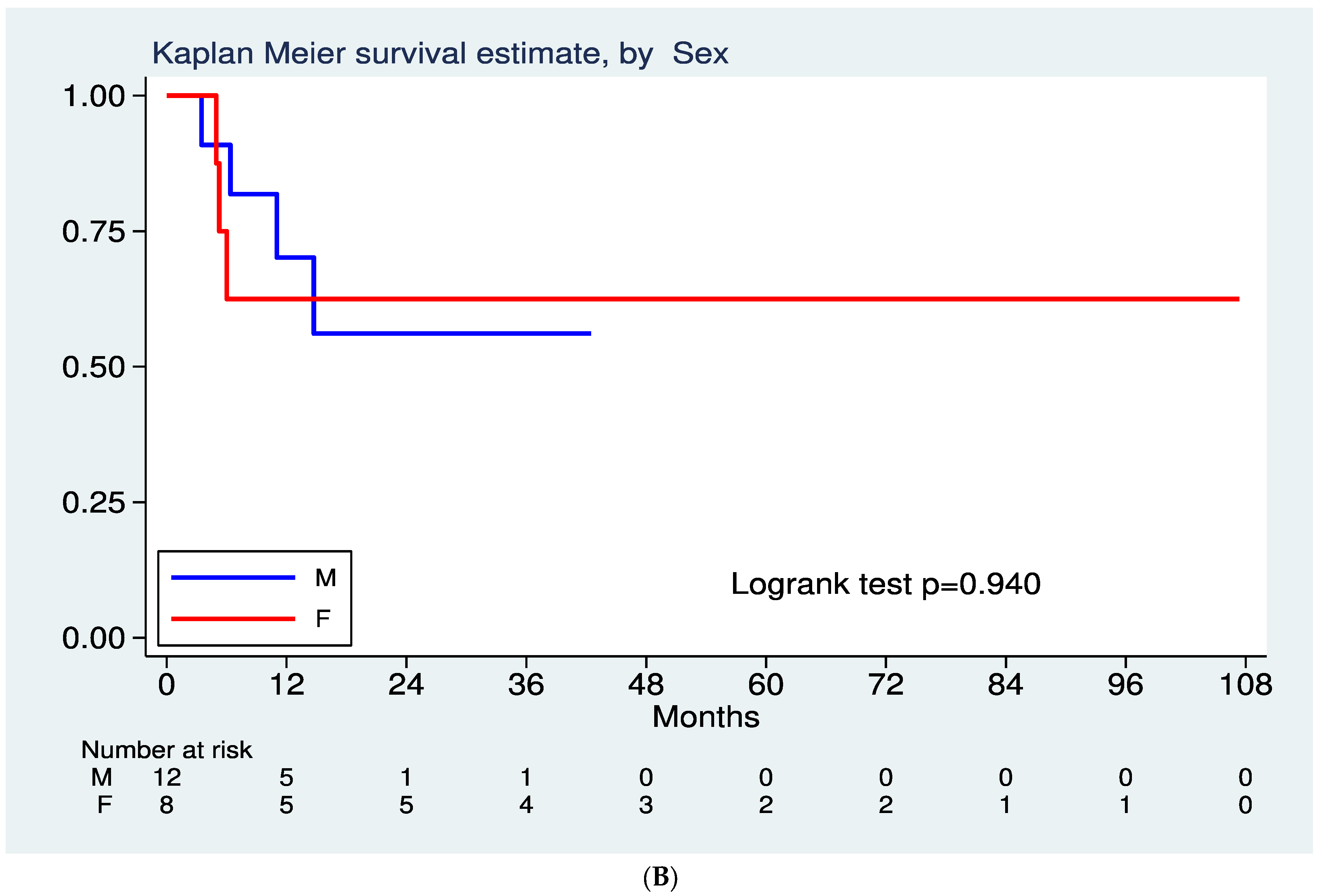Catheter Ablation of Atrial Fibrillation in Patients with Previous Lobectomy or Partial Lung Resection: Long-Term Results of an International Multicenter Study
Abstract
1. Introduction
2. Materials and Methods
2.1. Study Design
2.2. Catheter Ablation
2.3. Clinical Follow-Up
2.4. Statistical Analysis
3. Results
3.1. Procedural Outcome
3.2. Arrhythmic Events during Follow-Up
4. Discussion
5. Study Limitations
6. Conclusions
Supplementary Materials
Author Contributions
Funding
Institutional Review Board Statement
Informed Consent Statement
Data Availability Statement
Conflicts of Interest
References
- Haïssaguerre, M.; Jaïs, P.; Shah, D.C.; Takahashi, A.; Hocini, M.; Quiniou, G.; Garrigue, S.; Le Mouroux, A.; Le Métayer, P.; Clémenty, J. Spontaneous Initiation of Atrial Fibrillation by Ectopic Beats Originating in the Pulmonary Veins. N. Engl. J. Med. 1998, 339, 659–666. [Google Scholar] [CrossRef] [PubMed]
- Hindricks, G.; Potpara, T.; Dagres, N.; Arbelo, E.; Bax, J.J.; Blomström-Lundqvist, C.; Boriani, G.; Castella, M.; Dan, G.-A.; Dilaveris, P.E.; et al. 2020 ESC Guidelines for the diagnosis and management of atrial fibrillation developed in collaboration with the European Association for Cardio-Thoracic Surgery (EACTS): The Task Force for the diagnosis and management of atrial fibrillation of the European Society of Cardiology (ESC) Developed with the special contribution of the European Heart Rhythm Association (EHRA) of the ESC. Eur. Heart J. 2021, 42, 373–498. [Google Scholar] [CrossRef] [PubMed]
- Sasaki, N.; Okumura, Y.; Watanabe, I.; Hirayama, A. Pulmonary Vein Remnant as a Trigger Site for Atrial Fibrillation. Circ. J. 2013, 77, 494–496. [Google Scholar] [CrossRef] [PubMed]
- Smulders, S.A.; Holverda, S.; Vonk-Noordegraaf, A.; Bosch, H.C.V.D.; Post, J.C.; Marcus, J.T.; Smeenk, F.W.; Postmus, P. Cardiac Function and Position More Than 5 Years After Pneumonectomy. Ann. Thorac. Surg. 2007, 83, 1986–1992. [Google Scholar] [CrossRef]
- Kanmanthareddy, A.; Vallakati, A.; Yeruva, M.R.; Dixit, S.; Di Biase, L.; Mansour, M.; Boolani, H.; Gunda, S.; Bunch, T.J.; Day, J.D.; et al. Pulmonary Vein Isolation for Atrial Fibrillation in the Postpneumonectomy Population: A Feasibility, Safety, and Outcomes Study. J. Cardiovasc. Electrophysiol. 2015, 26, 385–389. [Google Scholar] [CrossRef]
- Fink, T.; Sciacca, V.; Heeger, C.; Vogler, J.; Eitel, C.; Reissmann, B.; Rottner, L.; Rillig, A.; Mathew, S.; Maurer, T.; et al. Atrial fibrillation ablation in patients with pulmonary lobectomy or pneumectomy: Procedural challenges and efficacy. Pacing Clin. Electrophysiol. 2020, 43, 1115–1125. [Google Scholar] [CrossRef]
- Rena, O.; Papalia, E.; Oliaro, A.; Casadio, C.; Ruffini, E.; Filosso, P.L.; Sacerdote, C.; Maggi, G. Supraventricular arrhythmias after resection surgery of the lung. Eur. J. Cardio-Thorac. Surg. 2001, 20, 688–693. [Google Scholar] [CrossRef]
- Vaitkevicius, R.; Saburkina, I.; Rysevaite, K.; Vaitkeviciene, I.; Pauziene, N.; Zaliunas, R.; Schauerte, P.; Jalife, J.; Pauza, D.H. Nerve Supply of the Human Pulmonary Veins: An Anatomical Study. Heart Rhythm 2009, 6, 221–228. [Google Scholar] [CrossRef]
- Ho, S.Y.; Cabrera, J.A.; Tran, V.H.; Farré, J.; Anderson, R.H.; Sánchez-Quintana, D. Architecture of the pulmonary veins: Relevance to radiofrequency ablation. Heart 2001, 86, 265–270. [Google Scholar] [CrossRef]
- Dixit, S.; Sauer, W.H.; Callans, D.J.; Marchlinski, F.E. Arrhythmogenic Potential of Pulmonary Venous Tissue: Triggers for Atrial Fibrillation Identified within the Remnant of a Vein. J. Cardiovasc. Electrophysiol. 2009, 20, 441–444. [Google Scholar] [CrossRef]
- Konstantinidou, M.; Schmidt, B.; Ouyang, F.; Koektuerk, B.; Kuck, K.H.; Chun, K.-R.J. Pulmonary vein isolation after left-sided pneumonectomy: Technically challenging but feasible and instructive. Europace 2009, 11, 389–391. [Google Scholar] [CrossRef] [PubMed]
- Raju, H.; Gomes, J.; Gonna, H.; Gallagher, M. Cryoballoon Pulmonary Vein Isolation After Lung Lobectomy. JACC: Clin. Electrophysiol. 2015, 1, 461–462. [Google Scholar] [CrossRef] [PubMed]
- Buchta, P.; Zembala, M.; Myrda, K.; Wojtaszczyk, A.; Witek, M.; Gąsior, M. Hybrid ablation in a patient with persistent, long-standing atrial fibrillation after left-sided pneumonectomy. Kardiol. Pol. 2018, 76, 1378. [Google Scholar] [CrossRef] [PubMed]
- Ohtaka, K.; Hida, Y.; Kaga, K.; Kato, T.; Muto, J.; Nakada-Kubota, R.; Sasaki, T.; Matsui, Y. Thrombosis in the Pulmonary Vein Stump After Left Upper Lobectomy as a Possible Cause of Cerebral Infarction. Ann. Thorac. Surg. 2013, 95, 1924–1928. [Google Scholar] [CrossRef]
- Demarchi, A.; Neumann, L.; Rordorf, R.; Conte, G.; Sanzo, A.; Özkartal, T.; Savastano, S.; Regoli, F.; Vicentini, A.; Caputo, M.L.; et al. Long-term outcome of catheter ablation for atrial fibrillation in patients with severe left atrial enlargement and reduced left ventricular ejection fraction. Europace 2021, 23, 1751–1756. [Google Scholar] [CrossRef]
- Poole, J.E.; Bahnson, T.D.; Monahan, K.H.; Johnson, G.; Rostami, H.; Silverstein, A.P.; Al-Khalidi, H.R.; Rosenberg, Y.; Mark, D.B.; Lee, K.L.; et al. Recurrence of Atrial Fibrillation After Catheter Ablation or Antiarrhythmic Drug Therapy in the CABANA Trial. J. Am. Coll. Cardiol. 2020, 75, 3105–3118. [Google Scholar] [CrossRef]
- Rienstra, M.; Van Veldhuisen, D.J.; Hagens, V.E.; Ranchor, A.V.; Veeger, N.J.; Crijns, H.J.; Van Gelder, I.C. Gender-Related Differences in Rhythm Control Treatment in Persistent Atrial Fibrillation: Data of the Rate Control Versus Electrical Cardioversion (RACE) Study. J. Am. Coll. Cardiol. 2005, 46, 1298–1306. [Google Scholar] [CrossRef]
- Kerr, C.R.; Humphries, K. Gender-Related Differences in Atrial Fibrillation. J. Am. Coll. Cardiol. 2005, 46, 1307–1308. [Google Scholar] [CrossRef]
- Dagres, N.; Clague, J.R.; Breithardt, G.; Borggrefe, M. Significant gender-related differences in radiofrequency catheter ablation therapy. J. Am. Coll. Cardiol. 2003, 42, 1103–1107. [Google Scholar] [CrossRef]
- Michowitz, Y.; Rahkovich, M.; Oral, H.; Zado, E.S.; Tilz, R.; John, S.; Denis, A.; Di Biase, L.; Winkle, R.A.; Mikhaylov, E.; et al. Effects of Sex on the Incidence of Cardiac Tamponade After Catheter Ablation of Atrial Fibrillation. Circ. Arrhythmia Electrophysiol. 2014, 7, 274–280. [Google Scholar] [CrossRef]
- Yunus, F.N.; Perino, A.C.; Holmes, D.N.; Matsouaka, R.A.; Curtis, A.B.; Ellenbogen, K.A.; Frankel, D.S.; Knight, B.P.; Russo, A.M.; Lewis, W.R.; et al. Sex Differences in Ablation Strategy, Lesion Sets, and Complications of Catheter Ablation for Atrial Fibrillation: An Analysis From the GWTG-AFIB Registry. Circ. Arrhythmia Electrophysiol. 2021, 14, e009790. [Google Scholar] [CrossRef] [PubMed]
- Arbelo, E.; Brugada, J.; Lundqvist, C.B.; Laroche, C.; Kautzner, J.; Pokushalov, E.; Raatikainen, P.; Efremidis, M.; Hindricks, G.; Barrera, A.; et al. Contemporary management of patients undergoing atrial fibrillation ablation: In-hospital and 1-year follow-up findings from the ESC-EHRA atrial fibrillation ablation long-term registry. Eur. Heart J. 2017, 38, 1303–1316. [Google Scholar] [CrossRef] [PubMed]
- Kaiser, D.W.; Fan, J.; Schmitt, S.; Than, C.T.; Ullal, A.J.; Piccini, J.P.; Heidenreich, P.A.; Turakhia, M.P. Gender Differences in Clinical Outcomes After Catheter Ablation of Atrial Fibrillation. JACC: Clin. Electrophysiol. 2016, 2, 703–710. [Google Scholar] [CrossRef] [PubMed]



| All Patients (n = 20) | RF Ablation (n = 13) | Cryoablation (n = 7) | p Value | |
|---|---|---|---|---|
| Median Age (years) | 65.2 (61.4–72.7) | 65.1 (61.1–67.3) | 72.7 (63.1–77.2) | p = 0.1 |
| CHA2DS2-VASc | 2.0 (1.0–2.5) | 2.0 (1.0–2.0) | 2.0 (1.0–3.0) | p = 0.5 |
| Female sex | 8 (40.0%) | 5 (38.5%) | 3 (42.8%) | p = 0.1 |
| LVEF (%) | 59% (55–61) | 60% (55–62) | 60% (56–63) | p = 0.2 |
| Clinical History | ||||
| Arterial Hypertension | 13 (68.4%) | 7 (53.8%) | 6 (85.7%) | p = 0.3 |
| Smoke habit | 5 (25.0%) | 2 (15.3%) | 3 (42.8%) | p = 0.2 |
| Diabetes mellitus | 1 (5.0%) | 1 (7.6%) | 0 (0%) | p = 0.1 |
| Pre ablation AAD | 3 (15.0%) | 2 (15.3%) | 1 (14.2%) | p = 0.1 |
| LAVi (mL/m2) | 30.7 (26.7–38.0) | 32.8 (28–41.0) | 27.4 (23.8–31.0) | p = 0.4 |
| Type of atrial fibrillation | ||||
| Paroxysmal AF | 13 (65.0%) | 8 (61.5%) | 5 (71.4%) | p = 0.1 |
| Persistent AF | 7 (35.0%) | 5 (38.4%) | 2 (28.5%) | p = 0.1 |
| PV resection | ||||
| Pneumectomy | 5 (25.0%) | 4 (30.7%) | 1 (14.2%) | p = 0.6 |
| Lobectomy | 15 (75.0%) | 9 (69.2%) | 6 (85.7%) | p = 0.5 |
| RSPV | 6 (30.0%) | 5 (38.4%) | 1 (14.2%) | p = 0.01 |
| RIPV | 4 (20.0%) | 0 (0%) | 4 (57.1%) | p = 0.01 |
| LSPV | 4 (20.0%) | 3 (23.1%) | 1 (14.2%) | p = 0.01 |
| LIPV | 1 (5.0%) | 0 (0%) | 1 (14.2%) | p = 0.01 |
| Septal PVs | 2 (10.0%) | 2 (15.3%) | 0 (0%) | p = 0.6 |
| Lateral PVs | 3 (15.0%) | 2 (15.3%) | 1 (14.2%) | p = 0.7 |
| All Patients (n = 20) | RF Ablation (n = 13) | Cryoablation (n = 7) | p Value | |
|---|---|---|---|---|
| Stump electrical recording | 13 (65.0%) | 9 (69.2%) | 4 (57.1%) | p = 0.6 |
| Stump firing | 4 (20.0%) | 4 (30.7%) | 0 (0%) | p = 0.2 |
| Balloon tip | - | Long (4 pts) Short (3 pts) | - | |
| Balloon size (mm) | - | 28 mm (4 pts) 23 mm (3 pts) | - | |
| Irrigated ablation cat. | 13 (65%) | 13 (100%) | - | - |
| Procedural time (min) | 126 (68.5–173) | 134 (101–207) | 70 (66–133) | p = 0.08 |
| Fluoroscopy time (min) | 16.1 (7–27) | 17.1 (7.2–39.7) | 15.3 (5.6–24.3) | p = 0.5 |
| Total ablation time (min) | 32.0 (16.3–55.9) | 41.2 (18.0–55.9) | 17.5 (16.3–18.0) | p = 0.3 |
| PVI isolation confirmation technique | ||||
| Exit block pacing | 3 (15.0%) | 3 (23.0%) | 0 | p = 0.5 |
| Entrance block pacing | 11 (55.0%) | 7 (53.8%) | 4 (57.1%) | p = 0.1 |
| Adenosine testing | 4 (20.0%) | 4 (30.7%) | 0 | p = 0.2 |
| EA remapping | 4 (20.0%) | 4 (30.7%) | - | - |
Publisher’s Note: MDPI stays neutral with regard to jurisdictional claims in published maps and institutional affiliations. |
© 2022 by the authors. Licensee MDPI, Basel, Switzerland. This article is an open access article distributed under the terms and conditions of the Creative Commons Attribution (CC BY) license (https://creativecommons.org/licenses/by/4.0/).
Share and Cite
Demarchi, A.; Conte, G.; Chen, S.-A.; Lo, L.-W.; Chen, W.-T.; De Potter, T.; Geelen, P.; Sarkozy, A.; Spera, F.R.; Reichlin, T.; et al. Catheter Ablation of Atrial Fibrillation in Patients with Previous Lobectomy or Partial Lung Resection: Long-Term Results of an International Multicenter Study. J. Clin. Med. 2022, 11, 1481. https://doi.org/10.3390/jcm11061481
Demarchi A, Conte G, Chen S-A, Lo L-W, Chen W-T, De Potter T, Geelen P, Sarkozy A, Spera FR, Reichlin T, et al. Catheter Ablation of Atrial Fibrillation in Patients with Previous Lobectomy or Partial Lung Resection: Long-Term Results of an International Multicenter Study. Journal of Clinical Medicine. 2022; 11(6):1481. https://doi.org/10.3390/jcm11061481
Chicago/Turabian StyleDemarchi, Andrea, Giulio Conte, Shih-Ann Chen, Li-Wei Lo, Wei-Tso Chen, Tom De Potter, Peter Geelen, Andrea Sarkozy, Francesco R. Spera, Tobias Reichlin, and et al. 2022. "Catheter Ablation of Atrial Fibrillation in Patients with Previous Lobectomy or Partial Lung Resection: Long-Term Results of an International Multicenter Study" Journal of Clinical Medicine 11, no. 6: 1481. https://doi.org/10.3390/jcm11061481
APA StyleDemarchi, A., Conte, G., Chen, S.-A., Lo, L.-W., Chen, W.-T., De Potter, T., Geelen, P., Sarkozy, A., Spera, F. R., Reichlin, T., Roten, L., Defaye, P., Carabelli, A., Boveda, S., Bourenane, H., Riesinger, L., Kochhäuser, S., Caixal, G., Mont, L., ... Auricchio, A. (2022). Catheter Ablation of Atrial Fibrillation in Patients with Previous Lobectomy or Partial Lung Resection: Long-Term Results of an International Multicenter Study. Journal of Clinical Medicine, 11(6), 1481. https://doi.org/10.3390/jcm11061481







